Morocco, spring 2010 (April 19th to May, 11th) |
|
| part 6 - from the Hammada(Ouarzazate) through the Reg(Tineghir) to the Erg(Merzouga) | |
| Friday, April 30th, 2010 Hammada or Hamada = rock desert Reg = gravel desert, the most hostile desert types Erg = sand desert, sand dunes Now we left the Ouarzazate area and drove east in direction to the big sand dunes. So, on each of the two days driving we had to go approx. 250 kms each and would like to have some stopps to look for herps and also want to see the big scenary of the two creeks/small rivers Dades and Todra, breaking through narrow gorges out of the High Atlas, we left early in the morning. Only approx. 20 kms east of Ouarzazate we looked for a possibility to come down to the Ouarzazate lake. We found a nice place close to the lake, but the herpetofauna was poor there (at least, what we could spot). Only one Dharb (Uromastyx acanthinura) and some Acanthodactylus boskianus. But our birdwatchers had good success (I will give a complete list of all observed birds - without daydreams, and the end of the complete report). |
|
 Ouarzazate lake |
|
| Next stop was at a dry river bed (Wadi). There we found some Agama bibronii, Uromastyx acanthinura and a hatchling of the last one. |
|
 Acanthodactylus boskianus: in front of his hole |
|
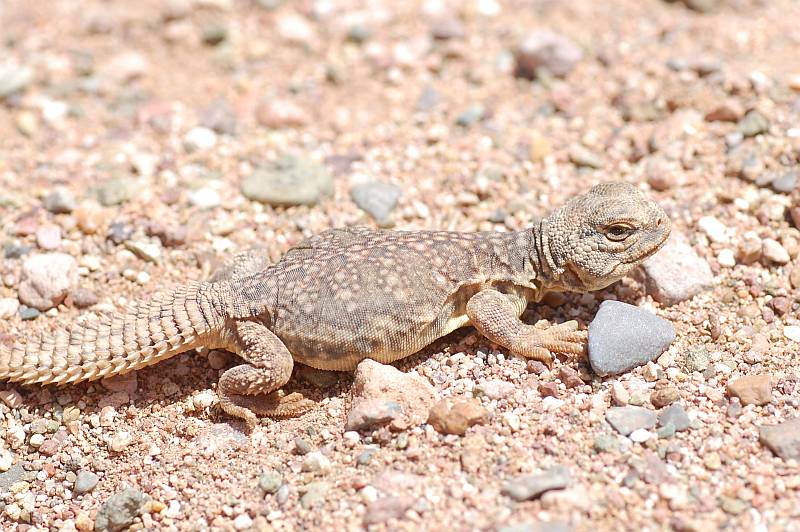 Uromastyx acanthinura Baby |
|
| Interesting was the finding of three Dharb tailes, in one case also with rests of the body skin. These tails were deposited at the edge of bushes, below bushes and on top of small bushes. So we have no idea, which animal might have killed these lizards and left the meals over. Sorry, I dont remember now, but Franz or Thomas showed me a hole at the edge of the riverbed with some tracks. I had a look on them and was sure, they are from a Colubrid snake and to 75 or 80%, the newest of the track lead inside. So Thomas and Franz started to dig out the rodent burrow. After a few minutes and 60 or 70 cm digging we saw it - and got it. An about 80 cms long Rhagerhis (formerly Malpolon and Scutophis) moilenis. This snake is called ┤false Cobra┤ by its habits to raise the head and neck and spred the neck a bit cobra-like. The locals, also snake-catchers handle this species with large respect and told me, these snakes are very venomous. I have found nothing on that in literature, but was not willing to try it on myself. Handling with (welding)gloves is much better! |
|
 Uromastyx acanthinura rest: Who was that? |
|
 Rhagerhis moilensis |
|
 Rhagerhis moilensis, portrait |
|
 Ragerhis moilensis; false cobra |
|
| We passed the village El-Kelaß M┤Gouna, the rose-village. Children tried to sell hearts of rose bloomings along the road and there is one shop next to next, selling rose water. | |
 Rocks at El-Kelaá M´Gouna |
|
| Only approx. 20 kms eastward we reached Boumalne Dades, the entry town to the Dades gorge. It is a nice bright green oasis within the desert. To the east there is a gap of about 60 kms to the next creek/river. This watershed separates the Dades/Draa from the Ziz river system. Some kilometers before the narrow gorge you pass very interesting rock formations. Now we entered the Dades gorge, drove on to the bent above the gorge, respectively. From the roadedge you have an impressive view down to the gorge. I remembered my first trip to Maroc in 1975, when I have been to both gorges, the Dades and Todra too. No ashalt road, no restauramts or hotels, sometimes driving in the riverbed. - Now, both gorges you may visit on a highway, perfect for tourists. |
|
 Kasbah near Boumalne Dades |
|
 village near the Dades gorge |
|
 rocks close to the Dades gorge |
|
 Richard Kopeczky: pictures of these rocks are a must |
|
 Thomas Bader: look at these rocks |
|
 Werner Mayer: these are only rocks! |
|
 Hannes Hill: easter egg in front of easter eggs |
|
 Thomas, Richard G., Richard K.: Restaurant in the Dades valley: everybody wants a Coke |
|
 Dades gorge |
|
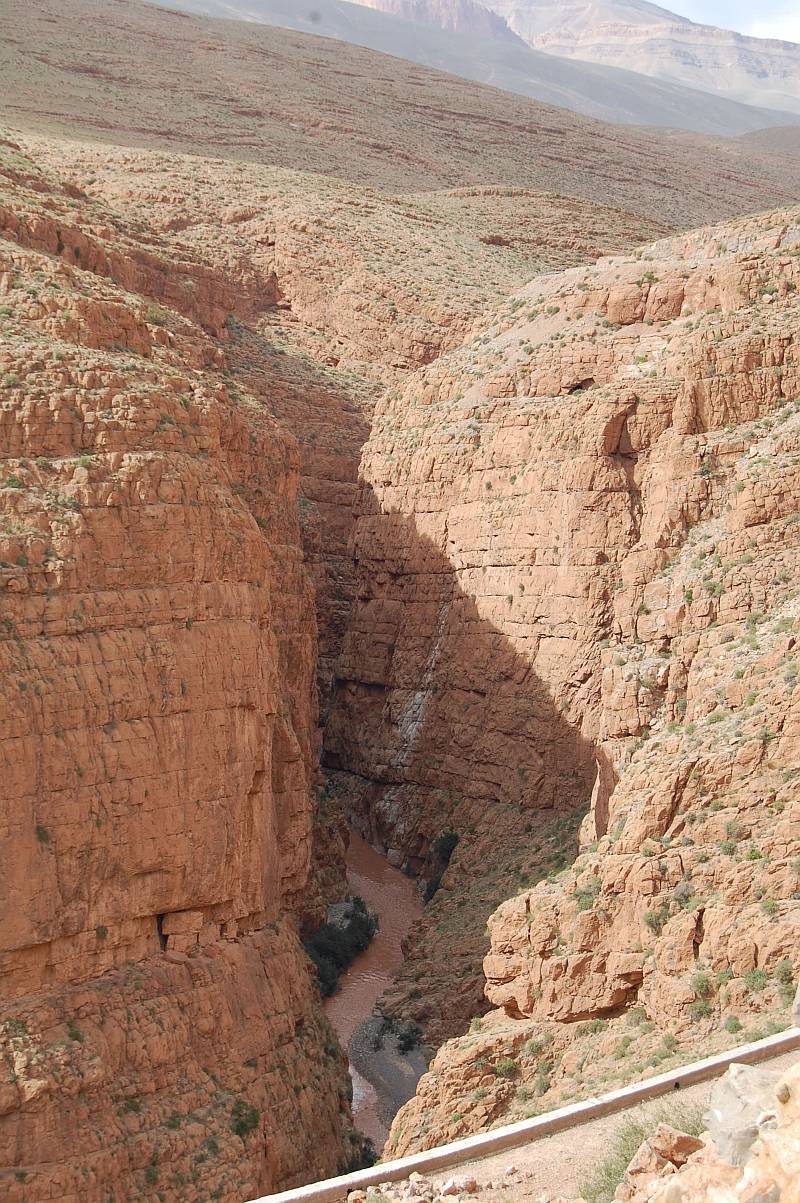 Dades gorge |
|
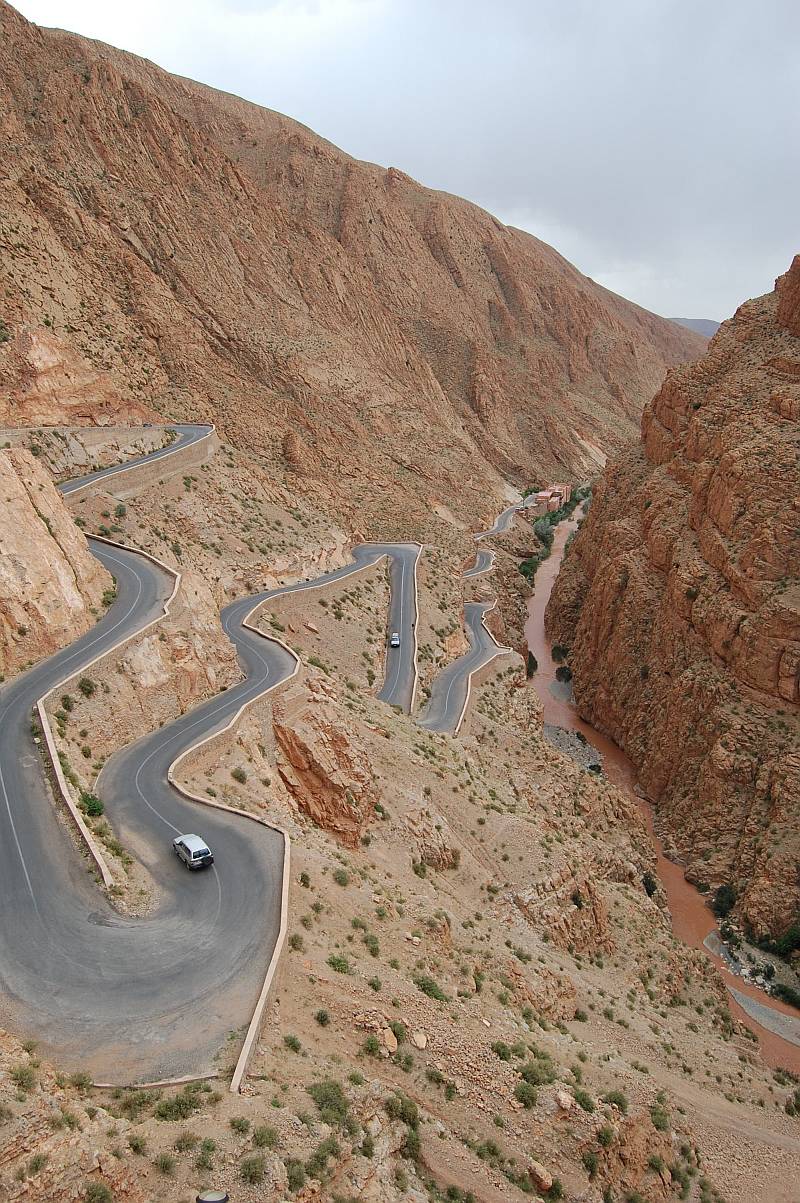 Dades gorge |
|
 To compare only: Dades gorge in June 1975: You may see the old gravel road climbing up. |
|
 School kids in Dades gorge, June 1975: we putted all in our beetle and took them up to their mountain villages |
|
| After visiting this, one of Moroccos landscape highlights, we went to Tineghir, where we spent the night. | |
 |
|
 |
|
| Saturday, May 1st, 2010 Only approx. 30 minutes driving from Tineghir we came to the Todra gorge, for me more impressive than the Dades one. Although not so deep like the one before, the Todra gorge has the advantage, you drive - or go - down in the gorge and must not look down. Like at the Dades gorge and Boumalne, here from the gorge out to Tineghir there is a green belt along the river in the desert. |
|
 Todra gorge |
|
 Todra gorge |
|
 Todra gorge |
|
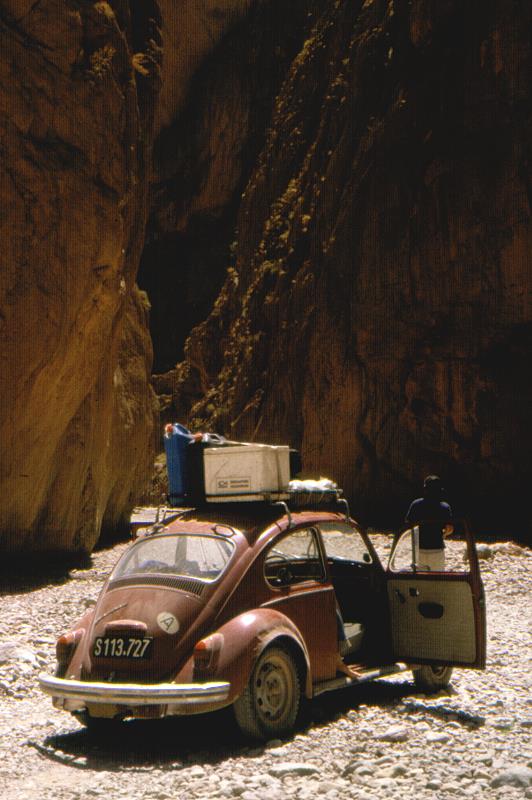 Todra gorge, June 1975: driving through the river bed |
|
 Todra gorge, September 2000: now a gravel road, but mostly for 4x4 only |
|
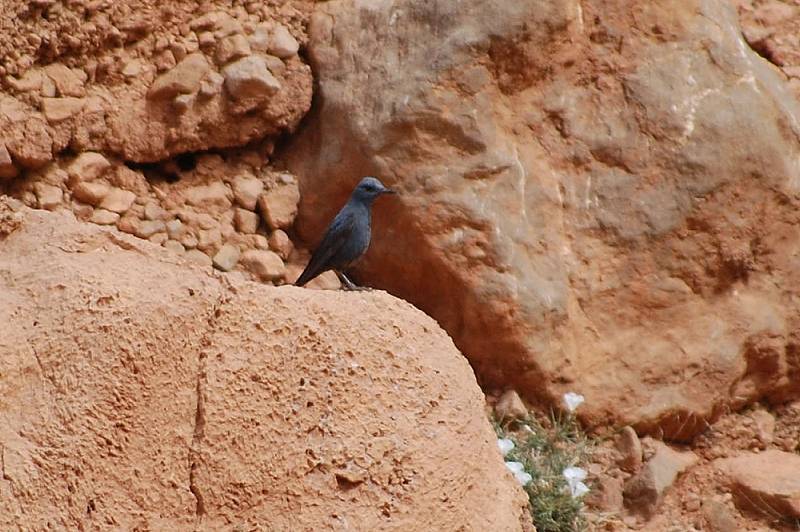 Monticola solitarius |
|
 Monticola solitarius |
|
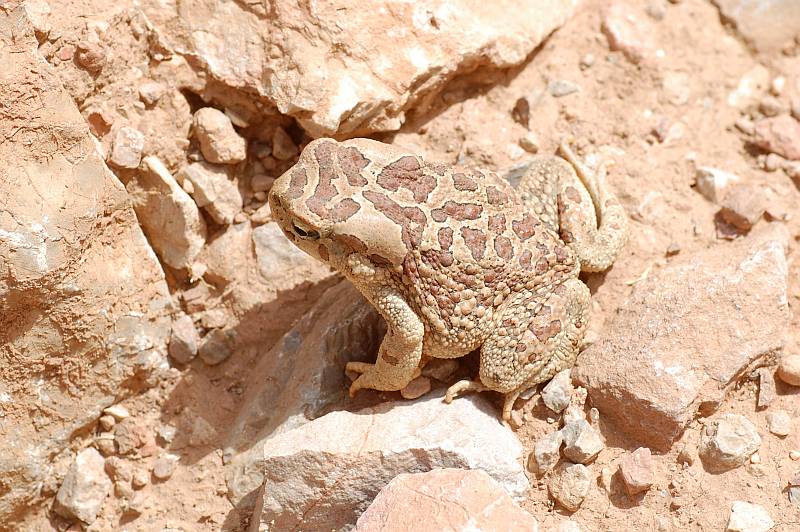 medium Bufo mauritanicus |
|
 Tineghir |
|
| Now we went on straight to Merzouga at the edge of the Erg, having only two short stops in the Reg. The Reg (a plain desert with small stones only) is the most hostile desert. Only in wadis there is a bit of vegetation and you may have a look for animals. At the first stop we found and digged out one Mesalina guttulata again, at the second under a bigger rock a large scorpion Androctonus mauritanicus a real poisonous one and the tiny gecko species Tropiocolotes tripolitanus At 4 p.m. we arrived in Merzouga. |
|
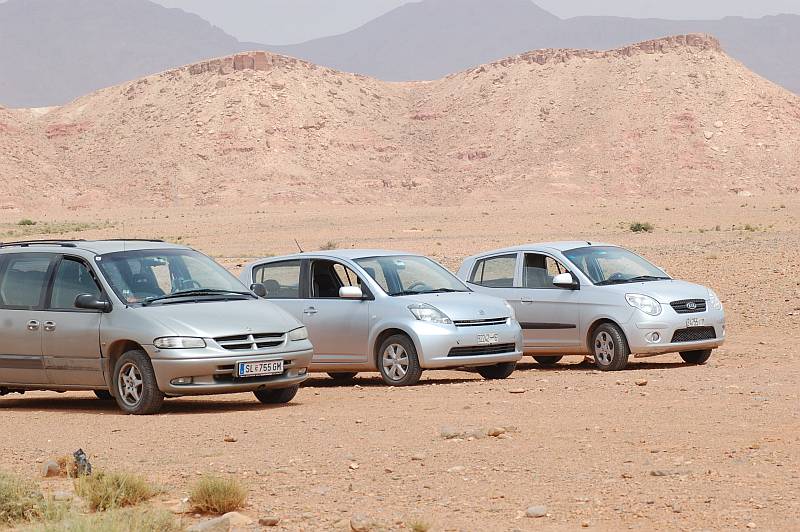 Austrian invasion in the Reg |
|
 Tropiocolotes tripolitanus |
|
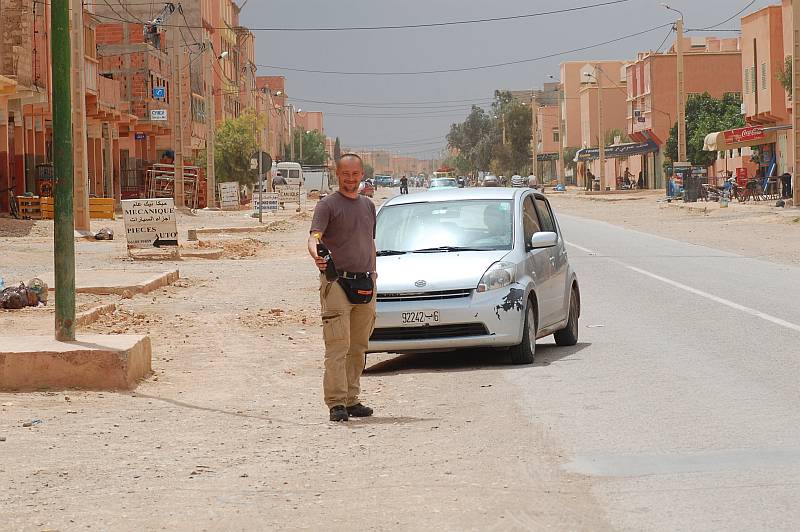 Hannes - and the way how Thomos parks a car (Goulmima) |
|
 Androctonus mauritanicus |
|
 Mesalina olivieri |
|
 The black Reg, in the background the dunes of Merzouga (Erg Chebbi) |
|
| part 1 - Introduction: Topography, climate, zoogeography | |
| part 2 - from Ceuta to Beni Mellal | |
| part 3 - from Beni Mellal to Marrakech | |
| part 4 - to Oukaimeden and from Marrakech to Ouarzazate | |
| part 5 - around Ouarzazate | |
You are here: |
part 6 - from the Hammada(Ouarzazate) through the Reg(Tineghir) to the Erg(Merzouga) |
| part 7 - in and around the sand dunes (Merzouga and adjected areas) | |
| part 8 - From Merzouga to Taroudant in the Souss valley | |
| part 9 - western part of the Souss valley and south to the Tiznit area | |
| part 10 - home along the Atlantic coast, list of observed Amphibians, reptiles and birds | |